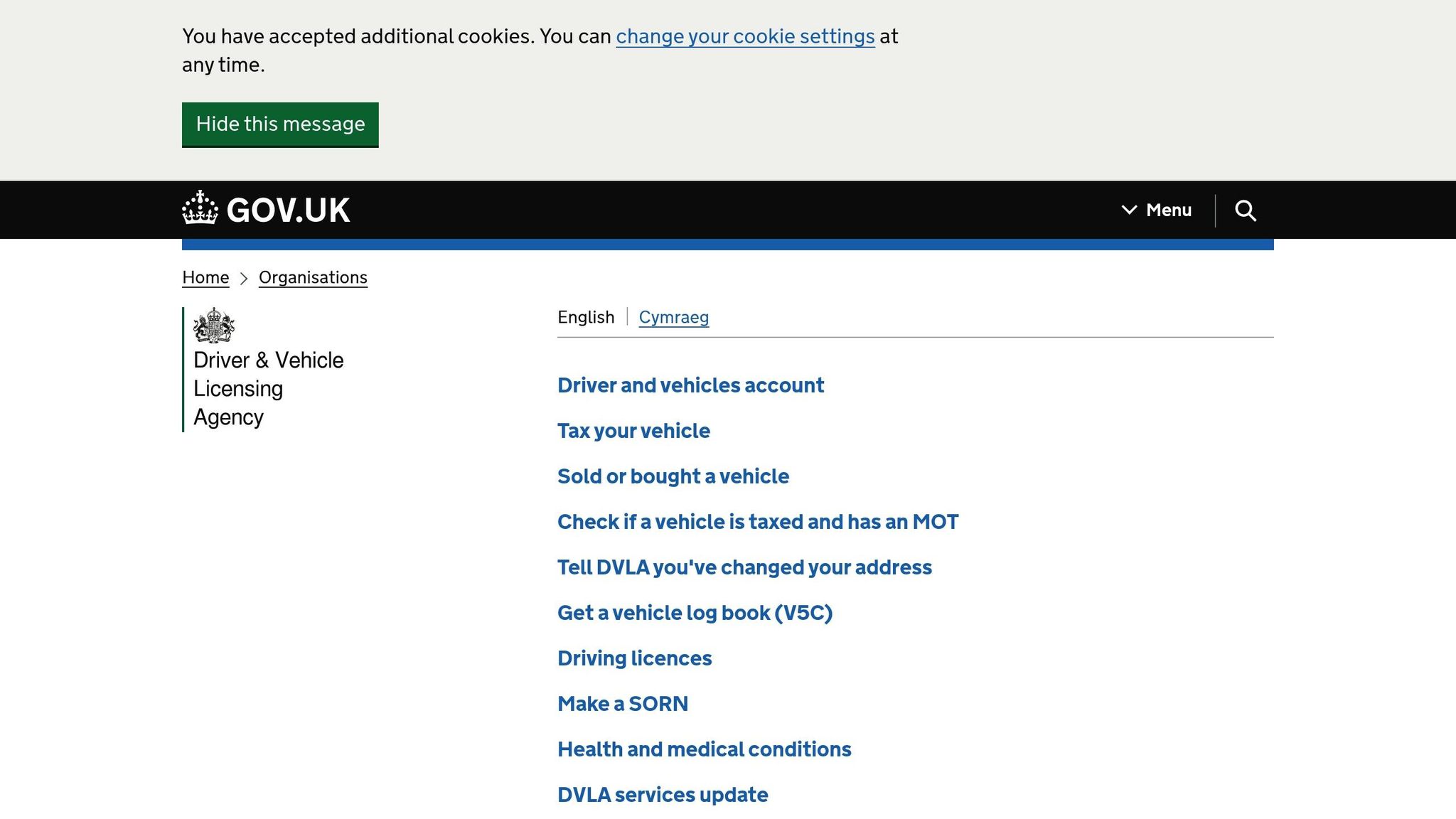Common Classic Car Title Issues and Solutions
Navigate common classic car title issues like lost V5Cs, incorrect details, and salvage classifications with practical solutions and prevention tips.

Struggling with title problems for your classic car? Here’s a quick guide to the most common issues and how to fix them. Title problems can delay sales, insurance, or ownership transfers, but most are solvable with the right steps. Here’s what you need to know:
- Lost or Missing V5C (Log Book): Apply for a replacement through the DVLA for £25. You’ll need your vehicle registration number, VIN, and original keeper details.
- Incorrect Title Information: Errors like mismatched VINs or wrong keeper details can be corrected by submitting a DVLA form V62.
- Category S/N Classifications: If your car has been written off, ensure proper restoration records and inspections to maintain its value and legal status.
- Ownership Disputes: Provide evidence like restoration records or ownership documents to resolve issues with the DVLA.
Prevent problems before they start: Keep your V5C safe, update details promptly, and verify title accuracy before buying. For more complex issues, consider seeking legal or professional advice.
Main Title Problems with Classic Cars
Lost or Missing V5C Documents
If the V5C (log book) is missing, you lose the legal proof of ownership, which means you can't sell or transfer the vehicle. This often happens when previous owners fail to return the log book to the DVLA or when documents are misplaced or damaged during long-term storage.
Check out 'Getting a New V5C' for information on how to get a replacement.
Incorrect Title Information
Errors like mismatched VINs or incorrect keeper details can make the title invalid and leave buyers vulnerable to fraud.
For instructions on how to correct these errors, see 'Fixing Wrong Title Details'.
Category S and N Classifications
- Category S: Applies to vehicles with repairable structural damage. These require a new registration number and an inspection by an engineer.
- Category N: Covers vehicles with non-structural damage. They keep their original registration and don’t need a post-repair inspection.
Both categories must be reported to the DVLA. For more details on handling these classifications, visit 'Managing Category S/N Titles'.
How to Replace a Lost or Missing Classic Car Title
How to Fix Title Problems
Here’s how you can address the issues mentioned earlier.
Getting a New V5C (for Lost or Missing V5C)
If your V5C is lost or missing, you can apply for a replacement online or by phone for £25, as long as the keeper and vehicle details remain the same. You should receive the new V5C within five working days. If it hasn’t arrived after two weeks, contact the DVLA. If six weeks pass without receiving it, you’ll need to reapply and pay the fee again.
Here’s what you’ll need to apply:
- Vehicle registration number
- VIN or chassis number
- The name and postcode listed on the original V5C
If any details have changed, you’ll need to apply by post using the DVLA form V62.
Next, let’s address how to correct errors in your V5C.
Fixing Incorrect Title Details
If there are mistakes in your logbook after replacement, double-check that all the details match your vehicle. Contact the DVLA immediately to request a corrected V5C, and make sure to keep copies of all correspondence for your records. You’ll need to submit form V62 with the updated details.
Now, let’s move on to dealing with salvage classifications.
Managing Category S and N Titles
Vehicles with Category S or N classifications have previously been written off by an insurer. Ensure you maintain detailed restoration records for these vehicles.
Finally, here’s how to handle disputes over a vehicle’s history or identity.
Settling History Disputes
If there’s uncertainty about your vehicle’s age or identity, the DVLA can issue a replacement VIN or a Q registration number. To resolve this, you’ll need to provide ownership documents and any restoration records. Vehicles with a Q plate must undergo a Basic IVA test. These records are also important for protecting the vehicle’s future value.
Where to Get Help
When DIY checks fall short, it's time to seek assistance from official sources and professionals.
DVLA Services

The DVLA offers an online vehicle enquiry service that allows you to check key details about a vehicle. This includes:
- Tax and SORN status
- MOT expiry date
- Date of first registration
- Date of the most recent V5C issue
- Vehicle specifications like engine size, fuel type, and emissions
If these checks don’t provide the answers you need, you can take it a step further. Writing to the DVLA can help you obtain additional details, such as information about the current or previous registered keeper. This can be especially useful for verifying a vehicle’s history or ownership records.
Legal and Expert Support
For more complex issues, particularly those involving high-value vehicles, professional help may be necessary.
Specialist automotive solicitors are experienced in handling title disputes, resolving cases of mis-sold vehicles, and negotiating refunds or returns.
Preventing Title Problems
Document Storage and Updates
Keep your V5C and related documents stored securely at home in a dry place, alongside other essential paperwork like passports and birth certificates. If you need to replace your V5C, refer to the section titled 'Getting a New V5C' for detailed instructions.
Make sure to inform the DVLA right away about any changes involving the keeper or the vehicle, such as:
- Changes to the vehicle's colour
- Engine modifications
- Replacements of the chassis or bodyshell
Not updating your name or address on the V5C could lead to fines of up to £1,000. While most updates to the V5C are free, certain changes - like adjustments to the wheel configuration, body type, VIN, chassis number, or a motorcycle's frame number - might require an inspection by the DVLA before the certificate is updated. Additionally, always confirm the title details before making a purchase to avoid future complications.
Pre-Purchase Checks
Before buying a vehicle, focus on these essential checks:
- Ensure the seller's identity and the vehicle's VIN match the details on the V5C.
- Examine the VIN plate for any signs of tampering or alterations.
- Get a complete vehicle history report to identify any liens, salvage titles, or inconsistencies.
If you're buying from a private seller, submit the 'New Keeper' slip and complete the DVLA registration process online as soon as possible. Avoid dealing with 'open titles' where the seller has signed without including buyer details.
Conclusion
To protect your classic car's title, focus on resolving issues like lost logbooks, incorrect details, and salvage classifications. Keep your V5C document in a safe place, promptly update any changes to the keeper or vehicle, double-check the VIN against your car, and report any discrepancies to the DVLA. These actions help maintain both the legal status and value of your vehicle.




